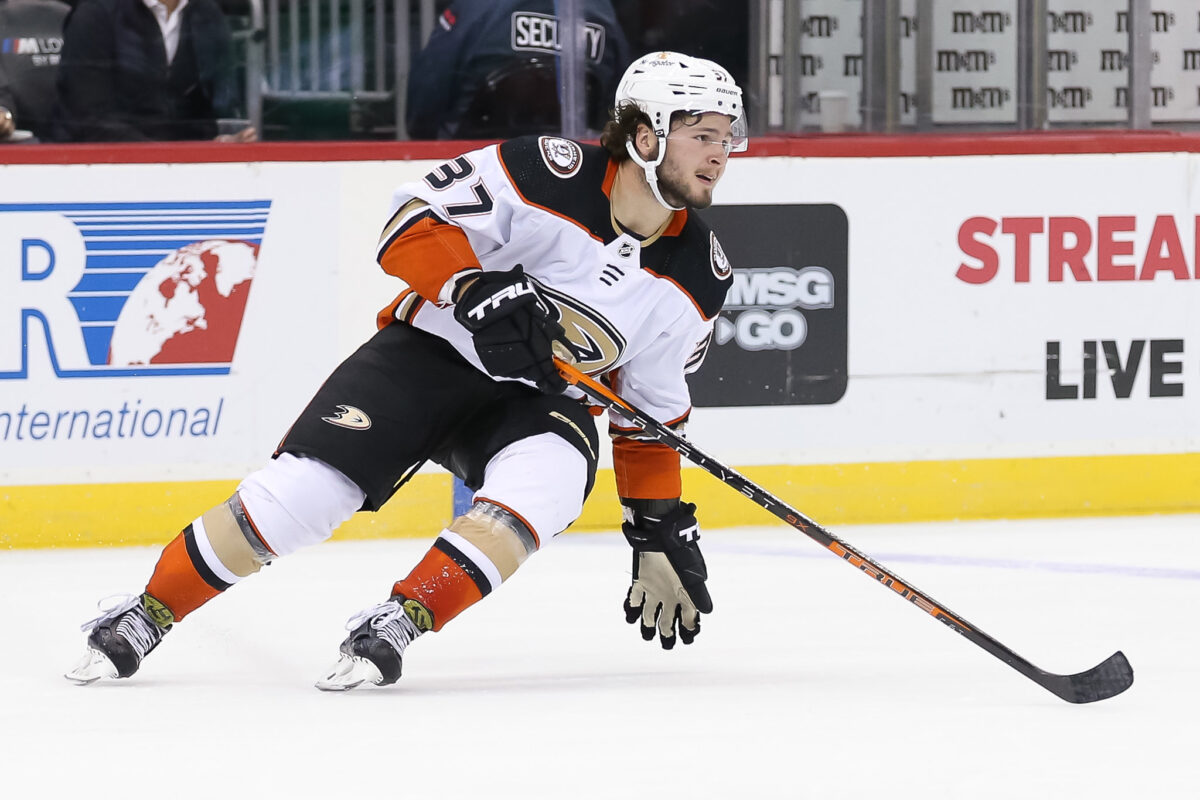With the conclusion of the 2022-23 season, the Anaheim Ducks are picking up the pieces of the worst year in franchise history. Their 23-47-12 record was the worst in the league, as their playoff drought has extended to five years. On June 28, the Ducks will have the second-overall pick in the NHL Draft, adding a blue-chip prospect to an already-packed talent pool. Before we get to the draft, let’s take a look at some of the players already on the roster with some season grades. Today we’ll take a look at Mason McTavish.
Related: Ducks’ 2022-23 Player Grades: Trevor Zegras
The Ducks selected McTavish with the third-overall pick in the 2020 NHL Draft. He’s one of Anaheim’s several high-end prospects, and he has managed to build an impressive resume in his teenage years. At 17 years old, he was playing professionally in Switzerland. Upon returning to North America, he nearly carried his Hamilton Bulldogs to a Memorial Cup title. Later that summer, he captained Team Canada at the World Junior Championship (WJC) and was named the tournament’s MVP. He has thrived at every level of the sport, so let’s see how he fared in his first full NHL season.
Climbing up the Depth Chart
As with most rookies, McTavish was given a sheltered introduction. He spent the first few weeks of the season on the third-line wing, but he was outperforming his role. By late November he was finally moved to his natural center position, but he began on the fourth line between Max Jones and Brett Leason. By December, it was obvious that he was the second-best center on the roster behind Trevor Zegras. Now at the conclusion of the season, there’s a fair argument he’s the best two-way center on the Ducks.

Anaheim has the second pick in the draft and will likely use it on Adam Fantilli. If selected, Fantilli would be the Ducks’ third top-10 pick dedicated to a center in the last five years, but this pick would create more flexibility rather than a logjam down the middle. Zegras and McTavish can begin the season as the top two centers while Fantilli begins on the wing, but to keep all three players in the top two groups, I would expect Zegras to make a more permanent move to the wing once Fantilli is ready to center an NHL line. In this time, McTavish should be seeing a lot of time as the team’s top center, which could lead to some big numbers if he’s dishing passes to Troy Terry and Adam Henrique.
Primary Option on the Power Play
Even as a teenager, McTavish was showing off his NHL-caliber shot in the Ontario Hockey League (OHL) and WJC. In his rookie season in Anaheim, his shot’s strength was tested as the team’s primary shooting option on the power play. On one hand, his team-leading seven goals on the power play suggest he was a good choice for the role. However, Anaheim’s 15.72 percent conversion rate on the power play was abysmal, and their next head coach would be justified in re-arranging the unit to find something resembling the league average. But of all the things that should change on the power play, McTavish’s role can stay safe heading into the 2023 season.
Anaheim’s shortcomings on the power play had less to do with McTavish being the primary option on the power play and more to do with him being the only option. The Ducks were downright predictable with the man-advantage. Every short pass was an attempt to open the cross-ice passing lane for a McTavish one-timer, and there was no contingency plan when the defense cheats to that side. Even with a moderately threatening second option that keeps the defense honest, the Ducks could see substantial improvement in their power play numbers while keeping McTavish as the primary trigger.
McTavish’s rookie season was encouraging, but ultimately limited by the system around him. Better years are ahead for the 20-year-old, especially as he matures and the roster continues to improve.
Grade: B-
Statistics courtesy of Hockey-Reference.